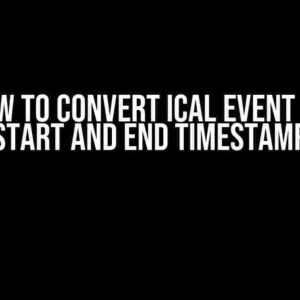Are you facing the frustrating issue of not being able to upsert in Chroma DB? You’re not alone! Many developers have found themselves stuck in this predicament, scratching their heads and wondering what’s going on. Fear not, dear reader, for we’re about to dive into the world of Chroma DB and explore the common culprits behind this issue, as well as provide you with step-by-step solutions to get you upserting like a pro!
What is Upsert in Chroma DB?
Before we dive into the troubleshooting process, let’s take a quick look at what upsert means in the context of Chroma DB. Upsert is a combination of the words “update” and “insert,” and it’s a powerful feature in Chroma DB that allows you to update existing records or insert new ones if they don’t already exist.
Upserting is useful when you need to synchronize data between different systems or update records in bulk. However, when things go wrong, it can be a real challenge to figure out what’s causing the issue.
Common Issues Causing Upsert Failure
So, what are the common culprits behind the “not able to upsert in Chroma DB” issue? Let’s take a look:
- Incorrect Data Types: Make sure the data types of your columns match the data you’re trying to upsert. A mismatch can cause the operation to fail.
- Missing or Incorrect Column Names: Double-check that the column names in your upsert statement match the column names in your Chroma DB table.
- Invalid or Malformed Data: Ensure that the data you’re trying to upsert is valid and doesn’t contain any syntax errors.
- Permissions Issues: Verify that the user account you’re using has the necessary permissions to perform upsert operations on the targeted Chroma DB table.
- Network Connectivity Issues: Check your network connection and ensure that it’s stable and working correctly.
Troubleshooting Steps
Now that we’ve covered the common issues, let’s walk through a step-by-step troubleshooting process to help you identify and fix the problem:
- Review Your Upsert Statement: Take a close look at your upsert statement and ensure that it’s correctly formatted and free of syntax errors. Use the Chroma DB documentation as a reference if needed.
- Verify Data Types and Column Names: Double-check that the data types and column names in your upsert statement match the ones in your Chroma DB table. Use the Chroma DB console or a tool like
chromadb-clito verify the table schema. - Check for Permissions Issues: Verify that the user account you’re using has the necessary permissions to perform upsert operations on the targeted Chroma DB table. You can check the permissions using the Chroma DB console or by running the
SHOW GRANTScommand. - Test Network Connectivity: Check your network connection and ensure that it’s stable and working correctly. Try pinging the Chroma DB server or running a simple query to test the connection.
- Check the Chroma DB Logs: Review the Chroma DB logs to see if there are any error messages or warnings that can help you identify the issue. You can use the
chromadb-clitool to view the logs.
Example UPSERT Statement
Let’s take a look at an example upsert statement to help illustrate the concept:
UPSERT INTO mytable (id, name, email) VALUES (1, 'John Doe', '[email protected]') ON CONFLICT (id) DO UPDATE SET name = 'John Doe', email = '[email protected]';
This example upsert statement will insert a new record into the mytable table if the id column doesn’t already exist. If the record does exist, the statement will update the name and email columns.
Best Practices for UPSERT Operations
To avoid common issues and ensure successful upsert operations, follow these best practices:
- Use Transactions: Wrap your upsert statements in transactions to ensure atomicity and consistency. This will help you roll back changes if something goes wrong.
- Validate Data Beforehand: Validate your data before attempting to upsert it to ensure that it’s correct and consistent.
- Use Column Lists: Specify column lists in your upsert statement to avoid errors and improve performance.
- Monitor Performance: Monitor the performance of your upsert operations and adjust your approach as needed to avoid bottlenecks.
Conclusion
Getting stuck with the “not able to upsert in Chroma DB” issue can be frustrating, but by following the troubleshooting steps and best practices outlined in this article, you should be able to identify and fix the problem. Remember to review your upsert statement, verify data types and column names, check for permissions issues, test network connectivity, and review the Chroma DB logs.
Upserting in Chroma DB is a powerful feature that can simplify data synchronization and updates. By mastering this feature, you’ll be able to take your data management skills to the next level and ensure that your data is always up-to-date and accurate.
| Common Issue | Solution |
|---|---|
| Incorrect Data Types | Verify data types and adjust upsert statement accordingly |
| Missing or Incorrect Column Names | Double-check column names and adjust upsert statement accordingly |
| Invalid or Malformed Data | Validate data before upserting and adjust upsert statement accordingly |
| Permissions Issues | Verify permissions and adjust user account or permissions accordingly |
| Network Connectivity Issues | Check network connection and adjust accordingly |
By following the steps outlined in this article, you should be able to overcome the “not able to upsert in Chroma DB” issue and take your data management skills to the next level.
Happy upserting!
Here is the FAQ section about “Not able to upsert in Chroma DB” with creative voice and tone:
Frequently Asked Questions
Stuck in a Chroma DB upsert crisis? Don’t worry, we’ve got you covered!
What could be the possible reasons for not being able to upsert in Chroma DB?
There could be several reasons why you’re not able to upsert in Chroma DB, such as incorrect table or column names, invalid data types, corrupted data, or even a simple typo in your code. Make sure to double-check your code and data before trying again.
Are there any specific error messages that can help me troubleshoot the issue?
Yes, Chroma DB usually provides error messages that can give you a hint about what’s going wrong. Look for error codes, syntax errors, or specific error messages that might indicate what’s causing the upsert issue. You can also check the Chroma DB logs for more detailed information.
Can I try disabling any caching mechanisms or session-level settings that might be interfering with the upsert?
Absolutely! Sometimes, caching mechanisms or session-level settings can interfere with the upsert operation. Try disabling them temporarily to see if that resolves the issue. You can also try restarting your Chroma DB instance or resetting your session to start from a clean slate.
Are there any Chroma DB configuration settings that I should check?
Yes, there are several Chroma DB configuration settings that might affect upsert operations. Check your settings for things like auto-commit mode, transaction isolation levels, or any custom configuration options that might be restricting upserts.
If none of the above solutions work, where can I get further assistance?
If you’ve tried all the above suggestions and still can’t upsert, don’t hesitate to reach out to Chroma DB support or your dedicated support team for further assistance. They can help you debug the issue, provide additional troubleshooting steps, or even offer custom solutions tailored to your specific use case.



